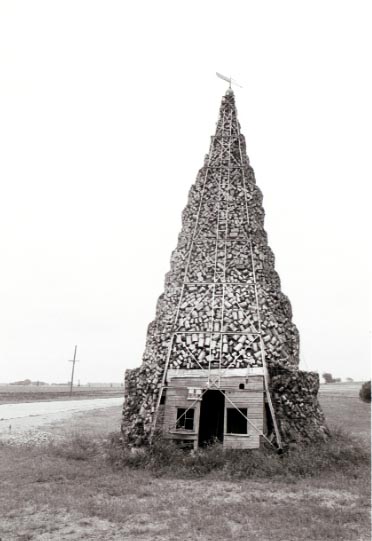
March 1989
April 1989
June 1989
March 1989
August 1989
April 1990
July 1990
August 1990
October 1990
January 1991
July 1991
December 1991
- "Junk becomes fantasy at art park"
- "Welcome to the Great Stink Lake"
- "The biggest birdhouse in North Dakota"


The Biggest Birdhouse in North Dakota
by Matt Bergstrom
Out on the floodplain of the Red River of the North, the horizon receded to an absurd distance. Faraway lines of railroads, telephone lines and gravel roads twisted past and then behind us silently. I was riding with Pat Kelley south on Highway 18 in eastern North Dakota. Presently an elevator town would break into the drab monoculture of some of the flattest farmland in the U.S. From the days when the plains were known as the "Great American Desert", travelers are still appalled at the cultural desert that must be crossed to reach the promised land. The table-flat floodplain here made easy passage first for the Great Northern Railway, then Highway 10, and now Interstate 94, each a faster track across the repulsive landscape. But here were sugar beets, sunflowers, soybeans growing and spreading to the edges of rich earth.
We came to an intersection near Casselton. What was that? Down the road to the right some kind of pyramid rose amid a few buildings and trees. Even from this distance it appeared ancient and enigmatic. Up close the tower seemed to be made of rusty old cans piled inside a chicken-wire cage built over a windmill tower.
The landmark is known locally as the Can Pile. In the 1930’s, when Highway 10 was the only major road across North Dakota, Max Taubert opened a gas station here. The station was an important stop for truckers to and from nearby Fargo. Taubert was a frugal man, and he saved all the empty oil cans from the station in a pile. He built a rack to catch every last drop from the oil cans. In time the pile grew, and so did Taubert’s business. He offered free ice water in his four stool lunch counter. The Can Pile went two smaller incarnations before reaching the size it is now. On the flat, treeless plain the tower could be seen for miles, increasing the expectation of a stop at Taubert’s station. The station was open twenty-four hours a day, seven days a week. Under the Can Pile, a small room was used as a gift shop and later a chicken coop. By the time of Taubert’s death in 1973, the property contained twenty-six buildings.
The history of the Can Pile was explained to us by George Loegering, the current owner of the tower. When we met him, he was just inside the large doors to his manufacturing plant. He was eager to tell us a few stories about the pile and Max Taubert. Although Taubert is gone and the pile has gotten no taller, Loegering mentioned, "the stories get bigger every year." "Ask any of the old-timers, they’ll tell you lots of stories about him." Loegering then proceeded to tell us a couple humorous legends about the cantankerous old man, but somehow they seemed familiar, as if we had heard a similar story before. Taubert died a bachelor at an old age, leaving only a brother behind.
When Loegering bought the property of Taubert’s gas station, he tore down all the old buildings. The Can Pile was saved, but it was in the way of plans for the manufacturing plant. Loegering explained how he puzzled over how to move the tower. Finally it was decided to dig out around the base of the tower. Heavy steel plates were slid under the supporting dirt and welded together. A bulldozer chained to the sled tried to pull the Can Pile but it was too heavy. Two bulldozers together could not pull it. "We had 100,000 pounds of machinery pulling on that thing," Loegering exclaimed, but only when a third bulldozer pushed from behind would the tower budge.
Soon after being moved to the other side of the building, on July 4th, 1978 a tornado descended on Casselton. Windows of the plant were torn out of the plant. Construction materials from a new home across the street were blown away. The Can Pile crumpled underneath and leaned back a few feet. Cans were scattered fields all around but somehow the pile survived mostly intact.
Now in more peaceful days the cans shone dully in the sun. Loegering believed the cans in the center of the pile, protected from the weather, were shiny as if they were new. Even the rusty cans on the outside still had quaint oil labels. From the holes in the can tops we could see straw and sticks. "Some people call it the biggest bird house in North Dakota!" Loegering said.
The old Can Pile no longer stands out as it did before. Trees planted in the 1940’s have grown taller than the pile and hidden it from the Interstate. Aside from a child on a bike, there was little traffic on Highway 10. But the old truckers still remember the landmark. When Loegering explains to a customer where his business is, a number of times he or she will ask "Is that anywhere near the Can Pile?"
photo by Pat Kelley
